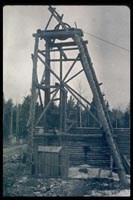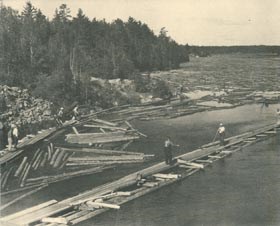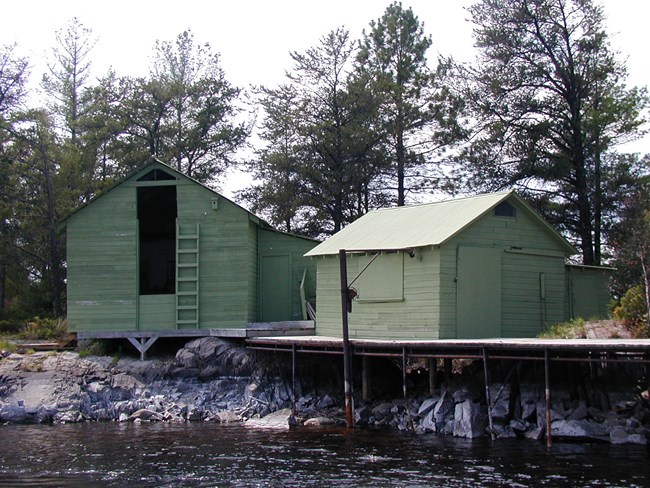
MN Historical Society MiningThe Rainy Lake "Gold Rush" During the summer of 1893, a local prospector searched for gold in the Rainy Lake area. In late July of 1893, while camping on a small island near Black Bay Narrows, he discovered a gold-bearing quartz vein - the "Little American" discovery. Given the good news and gold-bearing specimens, a Black Hills miner was hired to secure a title to the island and arrange financing. Development of the Little American Mine proceeded rapidly in the spring of 1894, along with the growth of the nearby settlement of Rainy Lake City to support the areas newfound exploration and mining activities. Rainy Lake City was incorporated on March 17, 1894, and by early summer was a bustling community of several hundred people with a school house, bank, general store, hotels, restaurants, a newspaper, hardware store, butcher shop, and several saloons. Following the development of the Little American Mine, several other prospects saw extensive activity during the summer of 1894, including the Lyle Mine north of Dryweed Island, the Big American Mine on Big American Island, the Bushyhead Mine on Bushyhead Island, and the Soldier Mine on Dryweed Island. Despite all of the numerous attempts to make gold-mining a profitable activity on Rainy Lake, the low production of the mines resulted in a gold-bust by 1898. The "Boom" was over, and the Rainy Lake City school and newspaper office were closed down. By 1901 the city was a ghost town. 
MN Historical Society LoggingThe depletion of the large stands of white pine in Michigan, Wisconsin, and central Minnesota through logging brought the lumber industry north into the area now designated as Voyageurs National Park. An initial logging frenzy occurred in the 1880s and 1890s, followed by the development of two major logging companies. The International Logging Company operated primarily in Koochiching County and transported timber to sawmills at International Falls and Fort Frances until 1937. In order to meet the constant water supply needs of sawmills, dams were constructed at International Falls, Kettle Falls, and Squirrel Falls in the early 1900s. The Virginia & Rainy Lake Lumber Company controlled much of the area to the east in St. Louis County, Minnesota. They conducted much of their operations until 1929 by rafting logs to Hoist Bay, which can still be viewed by park visitors. Hoist Bay is named for the machinery that was used to hoist floating logs out of the lake and onto a waiting train. The tracks extended out over the water to facilitate loading. From Hoist Bay the logs were taken to sawmills located in the town of Virginia, Minnesota. The extensive logging operations that occurred in the park area have altered the composition and structure of the park's forests. White and red pine are now a much smaller component of the park's forests, and there are fewer stands of large, mature trees. 
NPS Commercial FishingCommercial fishing followed the initial logging boom of the 1890s. Large-scale fishing operations began on the Rainy River as early as 1892. At its peak, in the late 1890s and early 1900s, roughly seven or eight large-scale fishing companies operated in the area, primarily on Crane Lake. The production of caviar, the eggs of lake sturgeon, was a major economic pursuit at this time. However, due to the great distance to markets, and the lack of refrigerated transport, these enterprises were relatively short-lived, although some remained in operation until the 1930s. Small-scale family fishing soon developed as a result, with the largest number or licensed family operations in the area reaching 48 in 1910. These family operations depended on local auctions at Kettle Falls to sell their catch. Commercial fishing was banned on Kabetogama Lake in 1923, and by 1942 only 10 licensed family operations were active in the area. Evidence of fishing camps and net-tarring sites exist in the park today, including the Oveson Fish Camp (ca. 1950s) which has been determined eligible for listing on the National Register of Historic Places. |
Last updated: April 30, 2018
